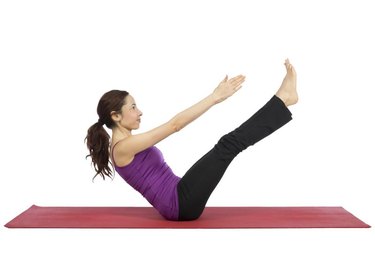
V-ups top the list of hardcore abs exercises that promise to get results. Sometimes called a jackknife or pike crunch, the V-up uses your core to rise up from a reclined position to a "V" shape, touching your toes with your hands. The move effectively trains your abs; it's a tough exercise that should be reserved for advanced exercisers with healthy spines.
Work Those Muscles
Video of the Day
The V-up primarily targets the rectus abdominis. This is the front abdominal muscle that makes up a defined six-pack — as long as you're lean enough to show the segments. Your obliques, located at the sides of your abdomen, assist in the movement, as do the hip flexors, inner thighs and several of the quadriceps muscles.
Video of the Day
No one abdominal exercise targets all of your ab muscles, so you can't rate one as the "best." However, the V-up can be a good choice for challenging the rectus abdominis, especially if crunches have become relatively easy for you. A complete ab workout will still include rotating moves, such as bicycle crunches, and stabilization exercises, such as plank.
Concerns With the V-Up
V-ups put pressure on your spine by subjecting you to compressive forces that occur when you repetitively flex and extend your spine. If you have back pain, especially in the lower back, it's best to leave V-ups out of your ab routine. It's just not a good exercise for you.
People who have neck issues should also avoid the V-up. You don't support your head with your hands while doing the exercise, meaning you have to activate your neck's stabilizing muscles to keep it long and straight.
V-ups aren't for the beginner, either. Build up abdominal strength through crunches — including variations on an incline and stability ball — before attempting the move.
Read More: Ab Exercises for People with Back Pain

Variations of the V-Up
Different variations on the V-up affect its intensity. Someone new to the move might begin with the standard version, while the weighted V-up is reserved for the hardcore, strong athlete.
Version One: Low Legs
This is the standard variation that's the best place to start.
Step 1
Lie on your back on a mat and reach your arms over your head until your hands touch the floor.
Step 2
Raise your legs and arms at the same time to create a V-shape. Touch your toes with your hands.
Step 3
Return to the fully reclined position to complete one repetition.
Version Two: Hovering Legs
This variation is more challenging and requires a lot of control. Move slowly to keep your form pristine.
Step 1
Lie on your back on the exercise mat with your arms overhead. Lift your legs about 6 inches off of the floor.
Step 2
Raise your legs up to a 45-degree angle to the floor as you also raise your torso to touch your toes and create the V-shape.
Step 3
Lower your upper body back down and your legs to the hovered position. Your legs should not touch the ground until you've completed all the desired repetitions.
Version Three: Add a Weight
Adding a dumbbell or medicine ball makes the V-up exceptionally difficult. You set up and execute the v-up just as you did for version two, but place the weight between your lower legs as you raise your legs and torso up into the v-shape.
Make the Most of the V-Up
Use these tips to make your v-up a good ab exercise, rather than one that wastes your effort:
- Avoid rounding your back as you rise up. Your spine should stay in a straight line and the arms long and fully extended.
- Put your upper back on the floor between each repetition to ensure you work the abs and not just the hip flexors.
- Keep the legs straight; no bent knees.
- Stop the exercise when your form starts to waver, even if that means you don't complete all the repetitions.
Read More: 10 Most Effective Ab Workouts